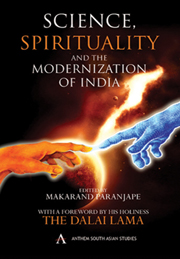Book contents
- Frontmatter
- Contents
- Notes on Contributors
- Foreword
- Editor's Preface
- I Science and Spirituality: East and West
- II Coming to Terms with Science: Some Change Agents
- III Building Bridges: Evolution, Consciousness and Healing
- IV Science and Spirituality: Culture, Society and Gender
- CHAPTER 13 Faith outside the Lab
- CHAPTER 14 The Calling of Practical Spirituality
CHAPTER 15 - Spiritual Hysteria: A Gendered Perspective
from IV - Science and Spirituality: Culture, Society and Gender
Published online by Cambridge University Press: 05 March 2012
- Frontmatter
- Contents
- Notes on Contributors
- Foreword
- Editor's Preface
- I Science and Spirituality: East and West
- II Coming to Terms with Science: Some Change Agents
- III Building Bridges: Evolution, Consciousness and Healing
- IV Science and Spirituality: Culture, Society and Gender
- CHAPTER 13 Faith outside the Lab
- CHAPTER 14 The Calling of Practical Spirituality
Summary
Trances, visions, speaking in many tongues, irrational social behaviour including the discarding of clothes have been widely interpreted by psychoanalysts as a psychopathological condition. However, parapsychologists are increasingly looking at the grey zone that blurs the rigidly held distinctions between psychoses and spirituality. Stanislav Grof, in his remarkable book Beyond the Brain: Birth, Death and Transcendence in Psychotherapy, published in 1985, goes beyond these neat divides between psychiatry and spirituality to take a fresh look at the phenomenon of ‘spiritual emergence’. To quote Grof:
In principle, Western mechanic science tends to see spiri- tual experiences of any kind as pathological phenomena. Mainstream psychoanalysis, following Freud's example, interprets the unifying and oceanic states of mystics as re-gression to primary narcissism and infantile helplessness and sees religion as a collective obsessive-compulsive neu-rosis […] The great shamans of various aboriginal tradi-tions have been described as schizophrenic or epileptic, and various psychiatric labels have been put on all major saints, prophets, and religious teachers. While many sci-entific studies describe the similarities between mysticism and mental disease, there is very little genuine apprecia-tion of mysticism or awareness of the differences between the mystical world view and psychosis […] These psychi-atric criteria are applied routinely and without distinc-tion even to such great religious teachers of the scope of Buddha, Jesus, Mohammad, Sri Ramana Maharishi or Ramakrishna. (p.334)
- Type
- Chapter
- Information
- Science, Spirituality and the Modernisation of India , pp. 255 - 271Publisher: Anthem PressPrint publication year: 2009
- 1
- Cited by



